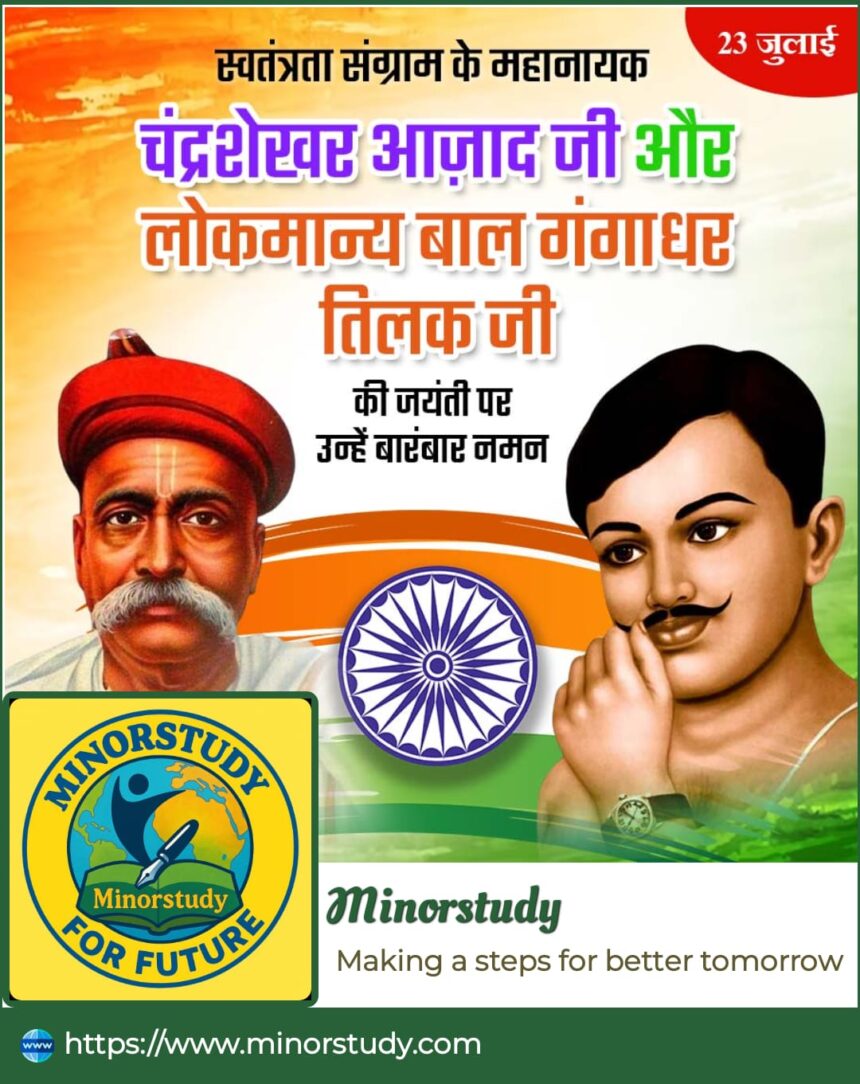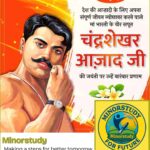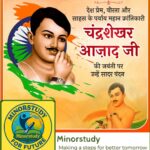🇮🇳 9 Timeless Truths That Prove Azad and Tilak Were the Most Fearless Architects of India’s Freedom
In the grand narrative of India’s independence struggle, two towering names shine with undying brilliance — Lokmanya Bal Gangadhar Tilak and Chandrashekhar Azad. Though from two different generations, these patriots shared one soul: a soul of defiance, fire, and unshakable love for Bharat Mata.
- 🕰️ Historical Backdrop: Two Eras, One Mission
- 🧬 Timeline of Two Freedom Warriors
- 🔥 9 Powerful and Rare Facts
- 1. Tilak Used Festivals as Weapons
- 2. Azad Gave His Identity to the Nation
- 3. Tilak Was Among the First Political Prisoners
- 4. Azad Lived and Died on His Own Terms
- 5. Both Were Teachers
- 6. Tilak Influenced the Entire Freedom Movement
- 7. Azad Was Bhagat Singh’s Mentor
- 8. They Rejected Fear and Favoured Action
- 9. Both Inspired Generations Across Religions
- 📖 Their Shared Significance
- 🌍 Why They Matter in 2025 and Beyond
- 🙋♂️ Frequently Asked Questions (FAQs)
- Q1: Did Azad and Tilak ever meet?
- Q2: Why is Tilak called “Lokmanya”?
- Q3: What ideology did they follow?
- Q4: Were they both jailed?
- Q5: What were their most iconic moments?
- 🕊️ Observance & Celebrations
- 💌 Wishing Messages
- 🧭 Impact on Daily Life
- 📝 Summary of Key Points
- ✍️ Conclusion: Two Souls, One Flame of Freedom
Tilak sowed the seeds of revolution with his pen and political strategy. Azad, decades later, watered that tree with his youth, blood, and courage. Let us delve into the extraordinary lives, rare facts, and everlasting significance of these legends whose ideologies shaped the moral backbone of modern India.
🕰️ Historical Backdrop: Two Eras, One Mission
Lokmanya Tilak (1856–1920) was among the first voices of Swaraj (self-rule).
Chandrashekhar Azad (1906–1931) embodied the revolutionary execution of that dream.
Tilak’s cry, “Swaraj is my birthright and I shall have it!” awakened a sleeping nation. A generation later, Azad turned that awakening into action with bullets, bombs, and bravery.
🧬 Timeline of Two Freedom Warriors
| Year | Tilak’s Journey | Azad’s Journey |
|---|---|---|
| 1856 | Born in Ratnagiri, Maharashtra | – |
| 1871–1879 | Education in Mathematics & Law | – |
| 1880s | Started newspapers Kesari and Maratha | – |
| 1890s | Leader of Indian National Congress’ extremist faction | – |
| 1905 | Vocal during Partition of Bengal | – |
| 1908 | Arrested for writings against British rule | – |
| 1920 | Died, but his legacy inspired Azad’s generation | Born in Bhabhra, MP |
| 1921 | Joined Non-Cooperation Movement at 15 | – |
| 1922–1928 | Joined HRA and later HSRA | – |
| 1931 | Martyred at Alfred Park | – |
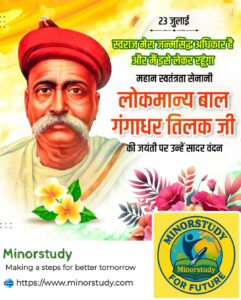
🔥 9 Powerful and Rare Facts
1. Tilak Used Festivals as Weapons
Tilak revolutionized Ganesh Utsav and Shivaji Jayanti, turning them into mass nationalist events that united communities.
2. Azad Gave His Identity to the Nation
At 15, he declared in court:
“My name is Azad, my father’s name is Freedom, and my address is Jail.”
3. Tilak Was Among the First Political Prisoners
He served six years in Mandalay jail, where he wrote ‘Gita Rahasya’, interpreting the Bhagavad Gita as a call to action.
4. Azad Lived and Died on His Own Terms
He never got caught and chose to shoot himself rather than be arrested.
5. Both Were Teachers
Tilak was a professor of mathematics, and Azad ran a disguised school in Jhansi to fund revolutions.
6. Tilak Influenced the Entire Freedom Movement
From Gandhi to Subhas Chandra Bose, all leaders acknowledged Tilak’s ideological groundwork.
7. Azad Was Bhagat Singh’s Mentor
He reorganized HSRA and guided Bhagat Singh, Sukhdev, and Rajguru during their early years.
8. They Rejected Fear and Favoured Action
Where Tilak used intellectual firepower, Azad used armed struggle — both with one goal: Freedom.
9. Both Inspired Generations Across Religions
Hindus, Muslims, Sikhs, and Christians equally revered both leaders for unifying all under the tricolour.
📖 Their Shared Significance
🧠 Intellectual Strength + Physical Action
Tilak laid the ideological foundation of assertive nationalism. Azad used physical resistance to challenge British authority. Together, they shaped a balanced freedom philosophy — mind and might united.
🗣️ Voice of the Voiceless
Tilak gave the Indian masses a voice through journalism.
Azad gave the oppressed a roar through revolution.
🔗 From Pen to Pistol
Without Tilak’s Kesari editorials and slogans, there might have been no Bhagat Singh or Azad. Azad was the fruit of Tilak’s tree.
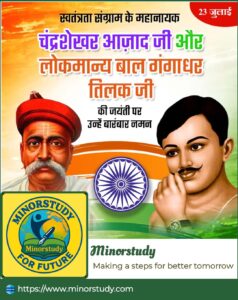
🌍 Why They Matter in 2025 and Beyond
| Area | Tilak’s Legacy | Azad’s Legacy |
|---|---|---|
| Politics | Assertive nationalism, people’s movements | Youth-driven revolutionary spirit |
| Education | Emphasis on self-reliance & Vedic values | Learning with action and sacrifice |
| Youth Empowerment | Belief in strength of awakened masses | Courage to act against injustice |
| Unity | Created festivals to unify people | Broke caste and religion barriers in HSRA |
Their stories are not relics of the past, but beacons for present and future India.
🙋♂️ Frequently Asked Questions (FAQs)
Q1: Did Azad and Tilak ever meet?
No. Tilak died in 1920; Azad became active shortly after. However, Azad was deeply inspired by Tilak’s writings.
Q2: Why is Tilak called “Lokmanya”?
“Lokmanya” means “accepted by the people.” The people gave him this title for his selfless service and leadership.
Q3: What ideology did they follow?
Tilak: Assertive nationalism, cultural awakening, Swaraj.
Azad: Socialist republicanism, armed resistance, youth revolution.
Q4: Were they both jailed?
Tilak: Yes, multiple times, notably in Mandalay for sedition.
Azad: Briefly at 15. Post that, he lived underground.
Q5: What were their most iconic moments?
Tilak: “Swaraj is my birthright!” speech.
Azad: Final stand at Alfred Park, refusing arrest.
🕊️ Observance & Celebrations
📅 Lokmanya Tilak Jayanti – July 23
Events held in:
Schools & universities
Political parties and nationalist forums
Cultural and academic societies
📅 Chandrashekhar Azad Martyrdom Day – February 27
Marked by:
Youth rallies
Tributes at Azad Park (Allahabad)
Documentaries and public speeches
💌 Wishing Messages
“Tributes to the lion hearts — Lokmanya Tilak and Chandrashekhar Azad — whose courage carved the path to our independence.”
“On this day, may the fierce patriotism of Tilak and Azad awaken the freedom fighter within us all.”
“Freedom was earned because of men like Tilak and Azad. Salute their sacrifices and rise to build their India!”
🧭 Impact on Daily Life
These two leaders aren’t just history book material. Their thoughts and actions echo in daily Indian life:
In our freedom to speak: Thank Tilak’s journalism.
In our student debates: Azad’s fearlessness to question.
In our festivals: Tilak’s vision of national unity.
In youth ambition: Azad’s sacrifices for the nation.
Every chant of “Jai Hind!” every moment of liberty we enjoy today, is rooted in their struggle.
📝 Summary of Key Points
| Topic | Chandrashekhar Azad | Lokmanya Tilak |
|---|---|---|
| Born | 1906, MP | 1856, Maharashtra |
| Died | 1931 (Martyrdom) | 1920 (Natural) |
| Famous For | Last stand in Alfred Park | “Swaraj is my birthright” |
| Ideology | Socialist revolution | Assertive nationalism |
| Contributions | HSRA, Bhagat Singh’s mentor | Mass awakening, festival nationalism |
| Observance | Feb 27 (Martyrdom Day) | July 23 (Jayanti) |
✍️ Conclusion: Two Souls, One Flame of Freedom
Chandrashekhar Azad and Lokmanya Tilak may have walked different paths, but both led to India’s independence. One wielded the pen and platform, the other the pistol and revolution. Their spirits were bound by unbreakable courage, self-sacrifice, and devotion to Bharat Mata.
In a world still plagued by injustice and inequality, these two offer more than inspiration—they offer a template of fearless living. Let us not just remember them—let us become them.
📢 Happy Lokmanya Tilak Jayanti and Chandrashekhar Azad Remembrance Day! Jai Hind, Vande Mataram!

